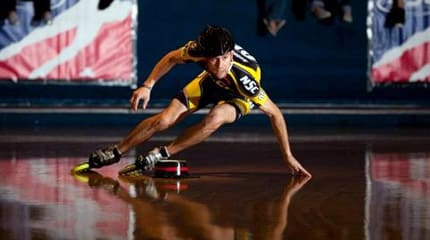Indoor Speed Skating: the rules, technique, and races
Of the three main disciplines of inline speed skating: road, track, and indoor, indoor is the most popular one in the United States (where I am from). There are many differences between indoor and track, or road, and the way the skaters skate, the rules, and the race types are all unique, and always make for a fun time skating.
Par Ben Brown

Indoor Speed Skating: Background Knowledge

In the U.S. we normally practice and hold races inside roller rinks, which are family fun facilities on a day to day basis, where everyone can come in and skate. The floors in many roller rinks are made of wood and are coated in a sticky plastic material that makes skaters’ wheels grip very well. A skating floor is not always gripy, however, as the plastic coating does wear off, and as a result the floor can become very slippery; though, roller rinks almost always coat their floors before a race in order to make for a faster and more fun event.
This is an image of what it looks like to put the coating onto a floor. This is not a normal wood floor, but the difference between the coated side (left) and uncoated side (right) is clear.
Indoor Speed Skating: The Rules
Indoor speed skating is often done on an oval, 100 meter track, with the exception being the Nira track, which is 110 meters. On the more common 100 meter track, called the USARS track, skaters skate around four cones which are placed on specific spots on the floor. If a skater cuts inside any of these cones during a race, they will be disqualified.
There are also many passing rules when skating. One important one being you cannot « ride a skater out » meaning that one person takes a pass and both skaters arrive to the cone at the same time and the skater on the outside is bumped of their course by the skater on the inside.
Another foul in the same category is the « ride in » where this time the skater on the outside moves in on the skater to the inside, knocking them off course. Both of these fouls result in the disqualification of the offending skater.
The start line rules are also very different from outdoor. Instead of two commands being given, « attention » and « go, » there are three commands given. These commands are « Skater to your mark, » « set, » and « go. » If a false start occurs, the offending skater is moved back four feet. If this skater false starts again, he is disqualified. The maximum number of skaters that can be placed on the line for one race is six. Finally, the general skating rules, which are also much different from outdoor, prohibit a large amount of physical contact. Skaters cannot pull each other’s hips, purposefully hit any other skater, or push or pull any skater to give themselves an advantage. There are many strict rules for indoor speed skating, but all of them are to keep the athletes safe and ensure that the sport is fair for all those participating.
Indoor Speed Skating: Technique

Indoor is similar to short track ice skating, in a way. In order to make a fast and efficient turn, skaters lean into the corner while keeping their shoulders and hips level with the floor. Indoor is not nearly as forgiving as track or road is for bad technique, and technique is one of the most important things for an indoor skater.
The similarities to outdoor are, of course, to cross all the way over and to always push to the side to get as much power as you can. Bad technique on a slippery floor can lead to a skater sliding more than if they had good technique. The center of gravity of the skater is always level with the floor, so much of their weight is pushing down, even though they are leaning. One thing you will see many indoor skaters do is put their hand on the floor and skate while touching the ground.
This doesn’t really provide any advantage, but it looks really cool! Technique is one of the most important facets of indoor, and is often the difference between the pros and the beginners.
The Races
The types of divisions and races at indoor meets and competitions make for some of the best racing in the sport. There are numerous age divisions that are only part of the indoor circuit, and are not present at any outdoor races. Instead of having ten year age divisions, like outdoor, there are five year age divisions, meaning that there are many more distances and divisions to skate in. The fastest age division, senior men, is also the largest age division, encompassing all skaters from ages 18 to 25. As far as the types of races, each age division gets three distance: a sprint, middle distance, and long race. For seniors, these distances are 500 meters, 1000 meters, and 5000 or 3000 meters. There are no points or elimination races at USARS regional and national competitions, though many invitational speed meets do hold opens and « last man » out events. All of the races that take place at indoor venues are fun and challenging for all skaters, and indoor is certainly a unique form of speed skating.

Links
(2009-present) / Mark S. Rinker
